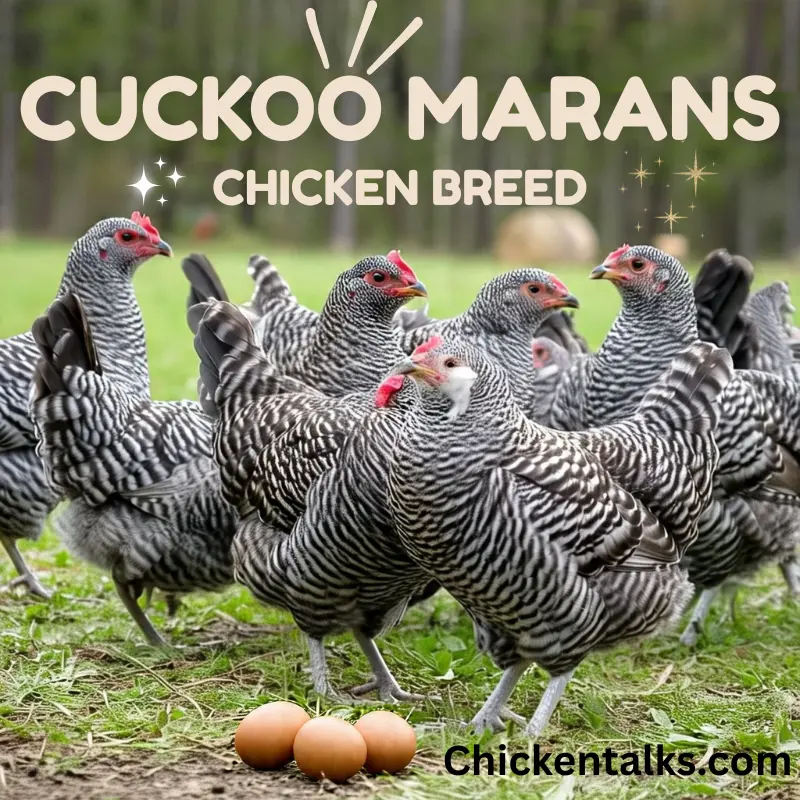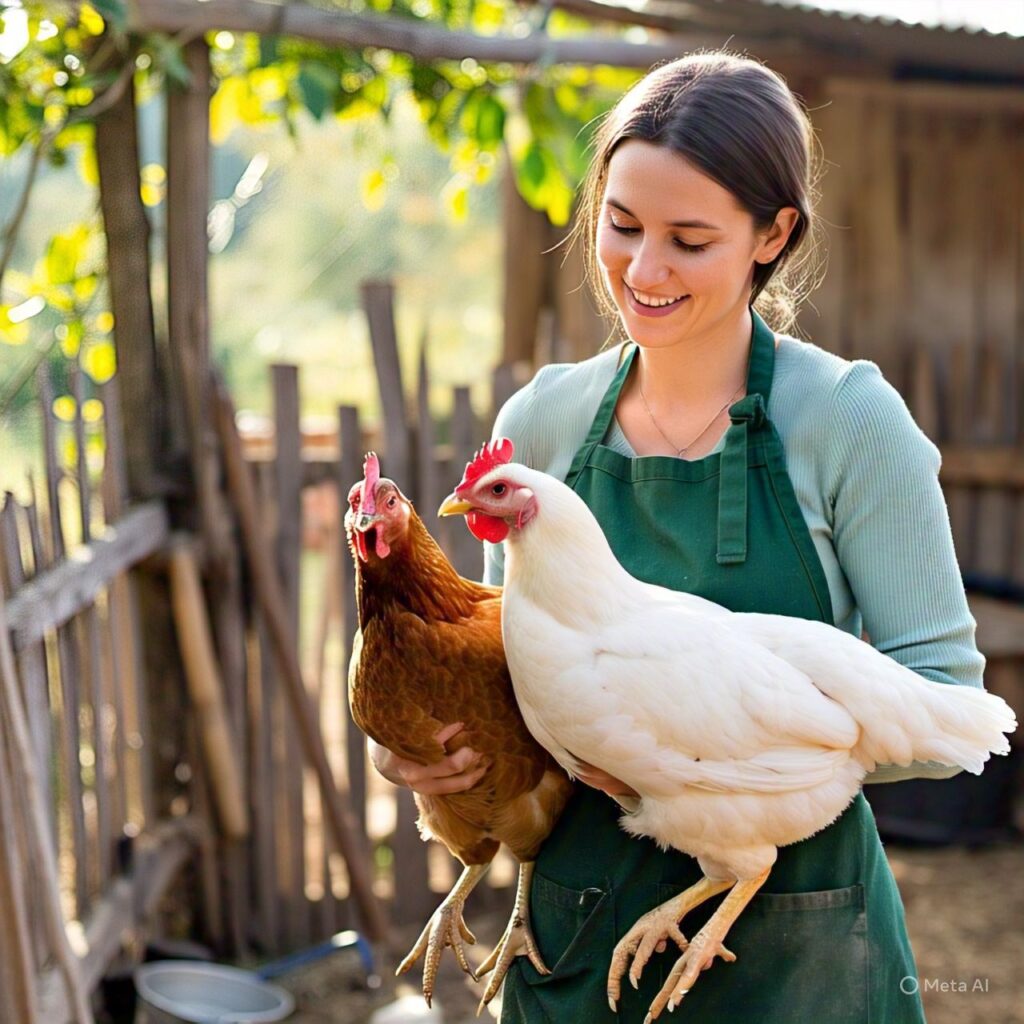Cuckoo Marans! Ever seen a chicken wearing what looks like a fancy striped pajama set? That’s basically what we’re dealing with here.
You stumbled upon this because someone probably bragged about their “chocolate eggs,” right?
Well, here’s the thing – these black and white striped beauties deliver on that promise. No joke.
I remember my first Cuckoo Marans egg. Cracked it open expecting the usual yellow yolk, but wow! The shell color alone had me questioning everything I knew about backyard chickens.
These French chickens don’t mess around when it comes to egg color.
But here’s what nobody tells you upfront – they’re the comedians of the chicken world too. Watch them strut around your yard like they own the place, and you’ll see what I mean.
Ready to dive into why these barred birds might just become your favorite flock members?
Firstly! What are we discussing today?
What is the History of Cuckoo Marans?
Are Cuckoo Maran Chickens A Heritage or Hybrid Breed?
Do Cuckoo Marans and Barred Rock look the same?
Tell me more about Plymouth Barred Rock.
What is the appearance of Cuckoo Marans?
How Big are Black Copper Marans Chickens?
What is the lifespan of cuckoo marans?
What is the egg colour of cuckoo marans?
What is the egg size of cuckoo marans?
How Many Eggs Do Cuckoo Maran Chickens Lay?
How to Breed Cuckoo Maran Chickens?
Do Cuckoo Marans make good pets?
Are Cuckoo Marans able to mix well with other breeds?
What is the broodiness behaviour of Cuckoo Marans?
Are Cuckoo Maran Chickens Hardy?
What Health Problems Do Cuckoo Marans Face?
Are Cuckoo Maran Chickens Good For Meat Production?
How Loud Are Cuckoo Marans?
What are the temperaments of cuckoo marans?
What are the Housing requirements of Cuckoo Marans?
Are Cuckoo Marans perfect for beginners?
Are Cuckoo Marans the right breed for you?
What is the History of Cuckoo Marans?
Back in France around the mid-1800s, some folks first bred what we now call the Cuckoo Maran breed.
They got named after the Marans region where they originated – pretty simple naming if you ask me. The location made sense since that’s where everything started.
These birds made their way to England in the early 1900s and became popular quickly. Why?
Those dark brown eggs caught everyone’s attention. The goal was getting a dual-purpose bird – one that could lay well and still be large enough for dinner.
Smart thinking from those old-timers who wanted their chickens to produce both good eggs and decent meat.
Are Cuckoo Maran Chickens A Heritage or Hybrid Breed?
They are usually considered a heritage breed, not a hybrid, and not officially recognized by the American Poultry Association (APA).
Many chicken keepers attempt to be recognised by APA, but this is not possible yet.
Do Cuckoo Marans and Barred Rock look the same?
They have a similar look to Plymouth Barred Rocks, so beginners never understand their difference, which makes their identity ununderstandable.
Both breeds support those black and white feathers that catch your eye right away.
But here’s where the key differences show up – this breed has darker feathers overall, and their barring pattern looks bolder than their Plymouth cousins.
Tell me more about Plymouth Barred Rock.
What is the appearance of Cuckoo Marans?
Their appearance also similar to Dominque Chickens.
The common features that stand out include a single comb that sits straight on their head (not floppy like some breeds), plus a bright red comb, medium bright red wattles, and bright red earlobes.
Their bare legs look clean and sturdy, while their tail shows off those same dark feathers with white details mixed in. Those fluffy feathers around their body give them a full, robust look that screams quality breed.
How Big are Black Copper Marans Chickens?
Roosters hit around 7 pounds on average, while hens typically reach 6 pounds – making them larger than many backyard chickens. Some hens might weigh 5.7 pounds, but they’re still large birds overall.
Their fluffy feathers make them look larger than their actual weight suggests. They’re average-sized compared to other breeds like Columbian Wyandotte, plus being cold-tolerant and hardy makes this breed perfect for tough weather.
What is the lifespan of cuckoo marans?
A healthy cuckoo maran chicken can live 7 years, but in most cases, their average lifespan is 3 to 7 years.
As this breed is used for meat as well, they live mostly 2-3 years, then they are handed over to the meat industry.
What is the egg colour of cuckoo marans?
This breed makes an excellent choice for those who are interested in brown egg-laying chickens. This breed is added to the list of brown egg-laying chickens.
This breed usually lays lighter brown eggs than black copper marans.
What is the egg size of cuckoo marans?
A mature chicken egg is normally medium to large. This is getting larger every day as time goes on, and the chicken has become large. Their egg weight is between 55 and 65 grams.
How Many Eggs Do Cuckoo Maran Chickens Lay?
Usually, they start laying eggs after 5 to 6 months of their age (about 20-24 weeks), but some of them can take up to 6-9 months, depending on different factors.
They lay 200-250 eggs per year normally in the first year, but my experience is that after their first year, their laying capabilities reduce to 10-15% every year.
How to Breed Cuckoo Maran Chickens?
Yes, they can breed naturally without human interaction.
This breed is recognized as the rarest one, because its existence is not officially recognized. Breeding new chickens of this breed can help them to remain in the world.
Do Cuckoo Marans make good pets?
Yes, they will be the best chickens as pets. Because they are calm and docile-natured, have an attractive appearance, and are easy to handle, they will be a good choice for new chicken keepers.
Are Cuckoo Marans able to mix well with other breeds?
Yes, they can mix well with other types of breeds, especially in backyard flocks. If you are going to keep this breed and add other types of breeds, you need to have something in mind.
They live well with other calm breeds like Orpingtons, Australorps, Plymouth Rocks, Easter Eggers, Cochins, while in my suggestion, you must be aware to keep with aggressive breeds like leghorn or gamefowl unless you are confident in your flock.
What is the broodiness behaviour of Cuckoo Marans?
The tendency of broodiness of this breed is low to moderate, which makes hens great moms.
Some hens in your flock show broodiness very well. You don’t need to hesitate; it makes them perfect mothers.
In my flock, hens are broody mostly in the summer season.
Are Cuckoo Maran Chickens Hardy?
They are well known for their good disease-resistant qualities, as well as their cold-hardy nature. Their dark and dense feathers keep them warm in winter, but they can struggle in hot weather if they don’t have proper shade.
These chickens need basic housing, like clean water and cooling from heat waves.
Be aware of symptoms of frostbite on the combs, wattles, and feet when temperatures drop significantly.
Even on the coldest day with temperatures hitting -22 or negative twenty-two with wind-chill, they handle enclosed unheated chicken coop conditions better than most breeds without needing a heater or brooder.
What Health Problems Do Cuckoo Marans Face?
They are generally disease-resistant, but can still be afflicted by some notable illnesses, and are likely to experience certain health issues that every owner should watch for with a watchful eye.
The abundance of feathers makes heat stroke a real problem during extreme weather. It gets difficult for them to cool down, so plenty of water and shade become important as a precaution.
Younger birds need extra care when integrating into your flock. Providing free-choice oyster shells as a calcium source plus grit helps strengthen their eggs and keeps your chicken healthy as a strong layer.
Being deficient in vitamins or calcium can lead to severe health complications and a shortened lifespan. Parasites are another general concern that affects this breed, just like any other chicken.
Common health risks include:
- Heat stroke from extreme temperatures
- Vitamin deficiencies affect overall health
- Calcium deficiency leading to weak eggs
- Parasites causing general health decline
- Illness from poor flock integration
Are Cuckoo Maran Chickens Good For Meat Production?
This breed is thought to be perfect for meat due to its size and flavor. These chickens are considered to be more flavourful than others. When this breed of chickens is 2-3 years old, they are good for meat production.
How Loud Are Cuckoo Marans?
These brown egg-laying birds can make above-average noise levels, so if you’re concerned about sound, they’re not a good candidate for urban farms.
I recommend keeping them in rural settings instead of densely populated neighborhoods.
The hens make a fair amount of chatter compared to quieter breeds. Roosters tend to crow regularly and quite loudly – several times throughout the day, making this a generally noisy breed.
From my experience, they say things similar to leghorns in volume and can easily outshine quieter chickens in areas where neighbors might complain about the sound.
What are the temperaments of cuckoo marans?
Friendly perfectly describes Cuckoo Marans chickens – we’ve raised several ourselves, and they’re never aggressive.
These breeds show a calm disposition that makes them great around children who enjoy being held and petted.
A docile nature doesn’t mean they won’t establish a pecking order in your flock.
They handle new coop situations well, though dominance can be the hardest part when integrating birds.
Some might chase others initially, but rooster behavior stays reasonable – he mounts his hen without hurting anyone, focusing on protecting the flock’s safety and happiness.
You could argue that this job makes them better at being lovingly protective. They become the Queens of your Coop through gentle leadership rather than force.
What are the Housing requirements of Cuckoo Marans?
After raising these beautiful birds for several years, I’ve learned that Cuckoo Marans are a large-sized breed that needs proper space planning. Each bird should have at least 4 square feet per bird in the coop area.
Space Requirements That Work:
The coop must be secure from predators’ attacks while maintaining limited drafts. An unheated space works fine, but pair it with an enclosed run of 10 square feet per bird, recommended for truly happy, healthy birds.
Weather Protection Strategies for Cuckoo Marans:
During hot, sunny weather, your chickens need a roofed area with lots of airflow. I always ensure free access to shady, cooler spots on days with temperatures upwards of 90 degrees.
My Marans thrive when they can move between sunny and shady areas. Sufficient ventilation prevents overheating while the roofed sections offer protection during extreme weather conditions.
Are Cuckoo Marans perfect for beginners?
They are a suitable option for beginners due to their docile temperament. Their gentle personality makes them a dual-purpose chicken that’s great for families just considering their first chickens.
Are Cuckoo Marans the right breed for you?
The key factor in your decision should be what you want from these birds to produce.
They provide a large quantity of meat and lay an average number of eggs annually, as well as brown eggs. This friendly breed can live easily in colder climates but struggles in hot climate conditions.
Each bird matures quickly compared to other breeds, making them an excellent choice when expanding your flock.
I’ve found minimal health issues with my Marans, though you might also want to include Copper varieties for more color diversity in your backyard setup.


